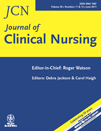A review and commentary on the factors that influence expressions of sexuality by older people in care homes
Abstract
Aim. The aim of this paper is to review the literature on factors that influence the expression of sexuality by older people in care homes.
Background. Sexuality is an intrinsic part of what we are, however there is evidence to suggest that the sexual needs of older people are often overlooked, particularly in long-term care settings. Whilst there is information about sexuality and its expression in later life, questions remain as to how this influences and is influenced by the behaviours and experiences of residents and staff in care homes.
Design. A systematic search of online databases.
Method. Databases using keyword and bibliographical searches in a specified timeframe were undertaken. Research studies ranging from 1996–2009 were selected for inclusion on the basis that they addressed issues relating to expressions of sexuality by older people in care homes. Forty articles were included in the review.
Findings. The review revealed a dearth of rigorous research on sexuality amongst older people in general and care home residents in particular. Issues identified in the literature were categorised into four broad thematic areas: sexuality and ageing, expression of sexuality in care homes, attitudes of staff and sexuality in dementia.
Conclusion. There is a dearth of rigorous research on the factors influencing sexual expression by care home residents. Attitudes of staff in care homes influence their perceptions about the extent to which the expression of sexuality by residents is considered to be problematic. This, in turn influences the emotional and behavioural responses of staff to the resident.
Relevance to clinical practice. There is need for nurses and other care staff to gain a better understanding of and insight into late life sexuality. This involves change at an educational level but also at an organisational and cultural level in long-term care settings.




